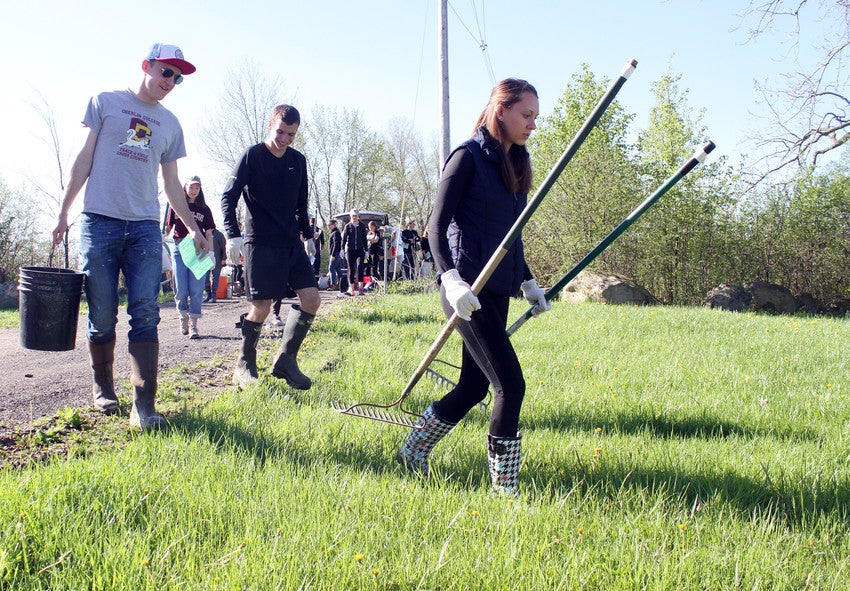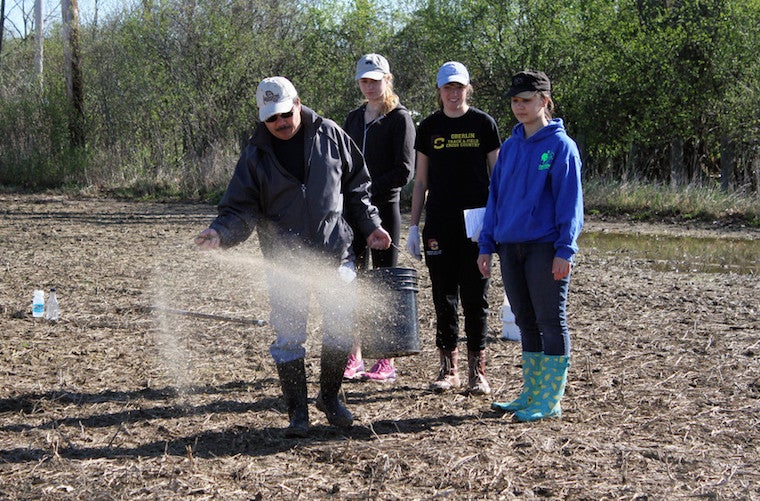Campus News
Groups Collaborate to Restore Prairie
April 27, 2017
Hillary Hempstead

Community members, students in Environmental Studies 101, and members of the Oberlin College Track and Field team volunteered to restore the prairie in Oberlin's Great South Woods on Sunday, April 23.
Photo credit: Anna Norris
When thinking about a prairie, one might call to mind images of grasslands in the Great Plains states, or the landscape described in the book series penned by Laura Ingalls Wilder. So it might be surprising to learn that Ohio is home to swaths of native prairie.
It is important to know that the prairie ecosystem is particularly vital for a range of wildlife, including grasslands birds and pollinators such as bees, butterflies, and ants. But the prairie ecosystem is quickly disappearing.
“More grassland habitats have disappeared than any other habitat type on the continent because of sprawl, climate change, and conversion to cropland and forest,” says Kate Pilacky, Firelands associate field director for the Western Reserve Land Conservancy. “A vast community of pollinators and birds is tied to these rich prairie habitats, and they are losing huge portions of their homes.”
So that’s why when student groups joined with the Western Reserve Land Conservancy to help restore a two-acre section of prairie on what’s known as Oberlin’s Great South Woods on Hamilton Street, it was a positive step for prairie conservation in the area.
The 63-acre property, which was targeted for conservation for more than a decade, was acquired by the Land Conservancy in October 2015. The area located directly west of the Oberlin Recreation Complex includes forests, wetlands, a sedge meadow, and 30 acres of previously farmed land. This year marks the first year the fields will not be farmed, which provided an opportunity for conservation partners to begin prairie restoration on the former fields while they are relatively clear of invasive plants. The restoration project will further prevent the potential establishment of invasive species.
The restoration effort was a collaboration of multiple groups. Those involved in the Land Conservancy’s project include Oberlin Environmental Studies 101 students, Oberlin College Track and Field team members, an Oberlin alumna, community members, and other local organizations. Funding from the Oberlin College Green EDGE (Ecological Design and General Efficiency) Fund also helped make the project possible.

A week prior to the Sunday, April 23 field planting, eight students in Environmental Studies 101 prepared the land for seeding by mapping out the project site and placing guide flags throughout the field in preparation for the restoration work. On the morning of the restoration, 23 students from the track and field team, Environmental Studies 101 students, and community volunteers planted a mixture of pollinator-friendly meadow and prairie seeds. It took the group of approximately 30 volunteers three hours to seed the field with a mixture of native plants.
Second-year Lea Milando became involved with the restoration project through her grant writing in a work-study program for the Western Reserve Land Conservancy and as a member of the track and field team.
“This restoration project is important because it increases habitat for native plant species, pollinators, and grassland birds, all of which have been declining in recent years,” says Milando. “The pollinators help to keep ecosystems healthy and will also help agricultural fields. Prairies can also play a role in carbon sequestration.”
The plan for the restoration was developed by an Oberlin graduate and former Land Conservancy student worker, Liz Fabis ’09. Fabis, who is now in graduate school for landscape architecture at Cornell University, was called in by her former employer at the Land Conservancy. Fabis was given the rough conceptual drawing that had already been sketched out.
“Because the seed had already been purchased, I just had to figure out how to create those forms in the appropriate dimensions for that amount of seed. I stayed fairly close to the initial designer's concept of a few naturalistic forms, making some small adjustments so people can begin to use and enjoy the first few acres of the restoration before the entire site has been completed,” says Fabis.
Along with working for the Land Conservancy during her time at Oberlin, Fabis had other connections to this particular project.
“I majored in environmental studies and ran track and cross country while I was at Oberlin. This project feels like a convergence of my Oberlin experiences,” says Fabis. “I was very lucky to have developed a strong connection to the town and the surrounding landscape through both the work I did for the Land Conservancy and all those long runs for track and cross country. This felt like a very special and meaningful way for me to say ‘Thanks, Oberlin!’”
With this first step of the restoration complete, the Land Conservancy plans to sow the field with additional native plants and seed this fall.
You may also like…
This Week in Photos: Sky Rockets
Bursts of green, orange, red, and white exploding in a night blue sky serves as inspiration for this week’s photo series.
Who is Joel Baetens?
Joel Baetens is an energy engineer who works energy efficient technology into construction projects. He started at Oberlin in January 2020. Find out more about Baetens in this installment of Who Am I?
Oberlin in Photos: The Green Side of Oberlin
In recognition of the 50th anniversary of Eary Day, we look back on some of the sustainability programs and milestones that support the college’s commitment to its goal of becoming carbon neutral by 2025.


